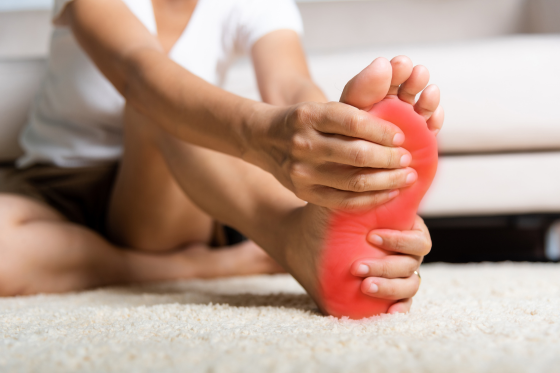Diabetes affects millions of people worldwide, and while managing blood sugar levels is crucial, one of the most overlooked complications is diabetic neuropathy symptoms. This condition can start subtly but progressively impact daily life, leading to discomfort, mobility challenges, and even long-term disability if left untreated.
If you have diabetes, it’s essential to recognize the early signs of diabetic neuropathy symptoms and take action before they worsen. In this article, we’ll break down what to watch for, why early detection matters, and how you can manage symptoms effectively to maintain your independence and well-being.
What Is Diabetic Neuropathy?
Diabetic neuropathy is a type of nerve damage that develops due to prolonged high blood sugar levels. Over time, elevated glucose can damage nerves throughout the body, but it most commonly affects the feet, legs, hands, and arms.
There are different types of diabetic neuropathy, including:
- Peripheral neuropathy – The most common type, affecting the feet, legs, hands, and arms.
- Autonomic neuropathy – Impacts involuntary bodily functions like digestion, blood pressure, and bladder control.
- Proximal neuropathy – Affects the hips, thighs, and legs, leading to muscle weakness.
- Focal neuropathy – Sudden nerve damage affecting a specific area, such as the head, torso, or leg.
While some people experience mild discomfort, others develop severe symptoms that interfere with daily life. That’s why recognizing diabetic neuropathy symptoms early is key to preventing complications.
Early Warning Signs of Diabetic Neuropathy Symptoms
Diabetic neuropathy often develops gradually, which makes it easy to overlook. However, paying attention to the early warning signs can help you take action before the condition worsens. Here’s what to watch for:
1. Numbness and Tingling
One of the first diabetic neuropathy symptoms people experience is numbness or tingling, often starting in the toes and spreading up the legs. It may feel like pins and needles or a subtle buzzing sensation. This happens because high blood sugar damages the nerves responsible for sending signals to the brain.
2. Burning or Sharp Discomfort
Some individuals describe diabetic neuropathy symptoms as burning, stabbing, or shooting discomfort, especially at night. This can make it difficult to sleep or find relief even when resting. If you experience unexplained sensations like these, it’s time to pay attention.
3. Increased Sensitivity to Touch
In the early stages, some people with diabetic neuropathy develop hypersensitivity—even light pressure from socks or bed sheets can feel uncomfortable. This heightened sensitivity can make everyday activities like walking or wearing shoes challenging.
4. Muscle Weakness and Coordination Problems
As nerve damage progresses, it can interfere with muscle control. You may notice weakness in your legs, difficulty standing up from a seated position, or balance issues when walking. These symptoms increase the risk of falls, which can be dangerous, especially for older adults.
5. Changes in Temperature Sensation
If you struggle to feel temperature differences, such as hot pavement or cold floors, this could be an early sign of diabetic neuropathy symptoms. Losing the ability to sense extreme temperatures can increase the risk of burns or frostbite.
6. Foot Ulcers or Slow-Healing Wounds
Nerve damage can reduce circulation to the feet, leading to dry skin, cracks, and slow-healing wounds. If you notice sores that don’t heal properly, they could become infected and lead to serious complications. Regular foot checks are essential for early detection.
7. Digestive Issues
Autonomic neuropathy can affect the nerves that control digestion. Symptoms may include bloating, nausea, constipation, or diarrhea. Some individuals develop gastroparesis, a condition where the stomach takes longer to empty, leading to discomfort and nutrient absorption problems.
8. Dizziness and Blood Pressure Changes
If you experience sudden dizziness when standing up or frequent lightheadedness, it could be due to nerve damage affecting blood pressure regulation. This can increase the risk of falls and injuries.
Why Early Detection of Diabetic Neuropathy Symptoms Matters
Ignoring diabetic neuropathy symptoms can lead to serious complications. Nerve damage is progressive, meaning it worsens over time if not addressed. Some of the biggest risks include:
- Permanent nerve damage that affects mobility and function.
- Increased risk of falls due to muscle weakness and balance issues.
- Foot ulcers and infections that may require medical intervention or even amputation in severe cases.
- Reduced quality of life, making simple activities like walking, exercising, or enjoying time with loved ones difficult.
The good news is that early intervention can slow the progression of diabetic neuropathy and help you regain control.
How to Manage and Reduce Diabetic Neuropathy Symptoms
While there’s no cure for diabetic neuropathy symptoms, several strategies can help manage discomfort and improve nerve health. Here are the top ways to take action:
1. Keep Blood Sugar Levels in Check
Maintaining stable blood sugar levels is the most important step in preventing further nerve damage. Work closely with your doctor to develop a management plan that includes diet, medication, and regular monitoring.
2. Stay Active with Gentle Exercise
Regular movement helps improve circulation and keeps muscles strong. Low-impact exercises like walking, swimming, and balance training can help maintain mobility and reduce symptoms. A physical therapist can guide you through safe, effective exercises tailored to your needs.
3. Support Nerve Health with Proper Nutrition
Certain vitamins and minerals, like B vitamins, magnesium, and omega-3 fatty acids, support nerve function. Eating a balanced diet with lean proteins, healthy fats, and fiber-rich foods can help protect nerve health.
4. Get Specialized Physical Therapy
Working with a physical therapist trained in neuropathy treatment can improve mobility, strength, and overall function. Therapeutic techniques like balance training, stretching, and neuromuscular exercises can provide relief and prevent further complications.
5. Wear Supportive Footwear
Proper footwear can reduce discomfort and protect your feet from injury. Look for shoes with good arch support, cushioned soles, and a wide toe box to prevent pressure on sensitive areas.
6. Consider Therapeutic Modalities
Advanced treatments like nerve stimulation therapy, laser therapy, or manual therapy can help reduce discomfort and improve nerve function. Consulting a neuropathy specialist can help you explore the best treatment options for your condition.
Take Action Against Diabetic Neuropathy Symptoms Today
If you’re experiencing diabetic neuropathy symptoms, don’t wait until they get worse. Early intervention is key to preventing further nerve damage and maintaining your independence.
At FYZICAL Therapy & Balance Centers, we specialize in helping individuals with diabetic neuropathy regain mobility, reduce discomfort, and improve their quality of life through customized therapy plans.
Take the next step today! Call us at (262) 349-9297 or click here to schedule a consultation. Our team is here to help you get back to feeling your best.
You don’t have to live with discomfort—let’s find a solution together!

